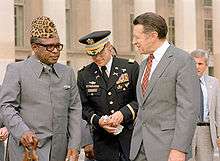Abacost

The abacost, abbreviation for the French "à bas le costume" (literally "down with the suit"), was the distinctive clothing for men that was promoted by Mobutu Sese Seko as part of his authenticité programme in Zaire, between 1972 and 1990. Zairians were banned from wearing Western-style suits with shirt and tie to symbolise the break with their colonial past. The abacost was a lightweight short-sleeved suit, worn without a tie, though sometimes with a cravat. It closely resembled a Mao suit.
The abacost was seen as the uniform of Mobutu's supporters, especially those who had benefited from his regime. When Mobutu announced a transition to multiparty democracy in 1990, he said that the Western suit and tie would be allowed, but that he continued to favor the abacost and it would still be considered the national dress. Subsequently, when the transitional government was sworn in, all its members were wearing abacosts.[1]
Arzoni in Zellik, Belgium produced the world's "chicest" abacosts.[2] Alfons Mertens, employed by Arzoni, became Mobutu's personal tailor, also making uniforms for him and his entourage.[2]
The abacost fell out of favour after Mobutu's fall from power.
See also
References
- ↑ Zaire: A Country Study POLITICAL REFORM IN THE 1990s - Proclamation of the Third Republic
- 1 2 David van Reybrouck. Congo: The Epic History of a People. HarperCollins, 2012. p. 381f. ISBN 978-0-06-220011-2.